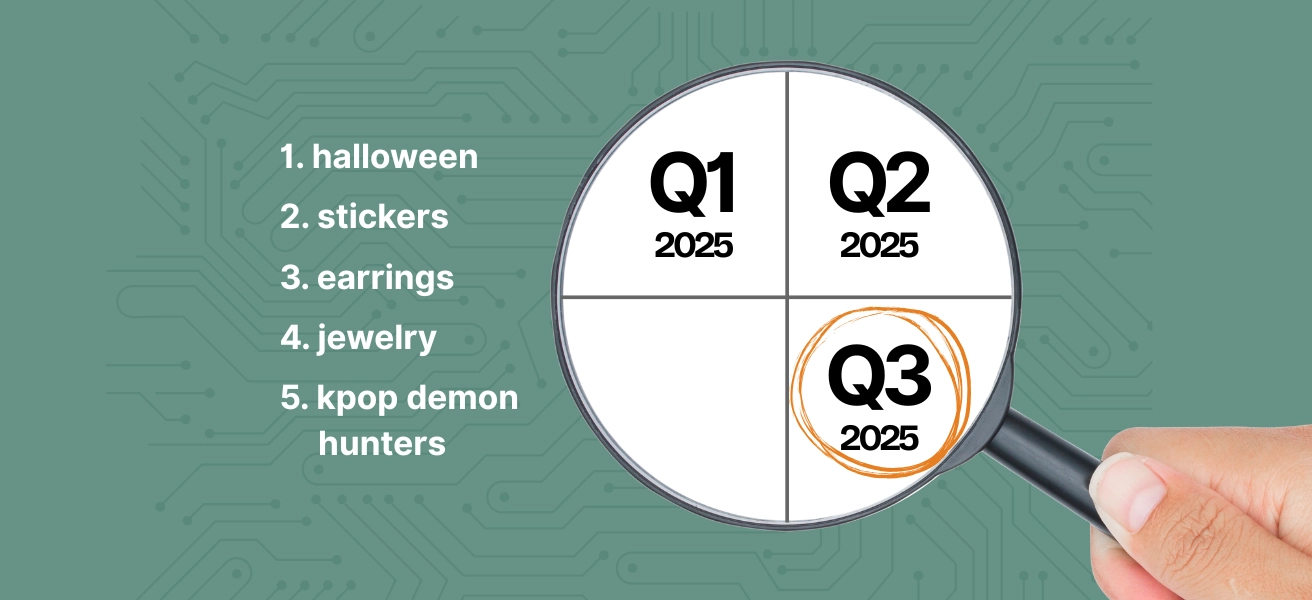Reading time: 12 minutes
Is it legal to sell fan art on Etsy? Well, there’s lots of conflicting advice out there. I’m Etsy Coach Pam Duthie. What to sell on Etsy is a topic we talk about a lot here. So today, let’s talk about selling fan art. For example, can you sell Disney items on Etsy? Now, I am not a lawyer, so I’m not qualified to give legal advice. Like many of you, I’m a maker and I do understand the temptation!
I remember when The Mandalorian came out back in November 2019 and The Child first appeared. Everybody wanted a Baby Yoda! And it sure seemed that Disney had dropped the ball! Christmas was around the corner and for these millions of fans Disney had nothing?* So, yeah we all had a go. And some folks who made Baby Yoda things to sell on Etsy made a killing that holiday season. Massive demand and no supply equals lots of money – but was it okay? Should I have jumped on the trend? Printed masses of copies of my Baby Yoda and stuck them on mugs and then retired to my yacht in the Caribbean?
What is a copyright?
For our discussion here, let’s begin with some terms. So, first: what is a copyright? A copyright covers recorded, artistic, or literary work. “Literary” here includes dances, photographs, tutorials. And it is an automatic international right. In other words, you don’t have to apply for it. Let’s say you take a photograph of a lake. Boom: you own the copyright to that image. You have the exclusive right to use it unless or until you give other people permission to use it. And further, you control how they use it. For example, you can stipulate whether it’s strictly for personal use, or commercial. That is, whether they can sell what they make with it. Can they reproduce it? Or do you retain that exclusive right? It’s entirely up to you.
What is a trademark?
A trademark can be a name, a word, a phrase, a slogan, or a design that’s associated with your company. It’s a unique identifier. And as with copyrights, in common law even if you don’t register it you can still have some protection. For instance, if people recognize your work from your trademark, you don’t have to register it for it to apply. These protections are meant to prevent someone else from passing themselves off as you or your brand. So they don’t confuse your customers into thinking they’re buying from you.
To prove something’s your trademark, you’d need to prove that you’ve been using it and customers identify it with you. Equally, you’d need to prove that someone else’s use of it harms your business. If this is a concern, you can get extra protection by registering your trademark.
What is infringement?
An infringement is a violation, a breach, or an unauthorized act. Intellectual property (IP) infringement refers to any violation or breach of an IP right. There are several types of IP rights, such as copyrights, trademarks, patents, industrial designs, and trade secrets. For our discussion today, we’ll stick with copyright and trademark violations.
Copyright infringement occurs when a copyrighted work is reproduced, distributed, performed, publicly displayed, or made into a derivative work without the permission of the copyright owner. And trademark infringement is similar. A violation of the exclusive rights attached to a trademark without the authorization of the trademark owner.
If your work is infringed, you have the right to recover for damages suffered as a result of their using your work. And also any profits they made. And there are further remedies, like seizure, destruction and penalties.
Note that what constitutes infringement is not black and white; there can be “gray areas.” That is, it can be subject to interpretation. Frequently, it needs to be determined in a court of law. And this is what allows people to think they may be okay. They hear about the “First- Sale Doctrine” or “Fair Use.” They’re able to say, “Oh, it’s all okay, because it’s not black and white.” But the trouble is that the only way you know if something is okay is by going to court. And are you really going to go to court against Disney? I’m not.
Copyright infringement
As it stands now, this is generally how it works for copyright. Like other third-party seller platforms, Etsy claims “safe harbor status” under the DMCA (Digital Millennium Copyright Act). This protection relieves Etsy from liability for copyright infringement by its users. And until the copyright holder complains, Etsy needn’t do a thing about infringing listings. Under the provisions of its safe harbor status, Etsy takes no part in deciding who is or isn’t infringing. Rather, Etsy is only obliged to respond to the claimant by removing the listing. No questions asked. Etsy is a neutral party.
Next, Etsy is required to let you know why it’s been taken down. Then you have a certain amount of time to “counterclaim.” To say back to Disney, “Nope, that’s not your stuff; I’m totally okay to sell it.” And if you counterclaim, if you say that their claim is incorrect? Then they can either drop it, whereupon you’re okay to sell the item. Or they can take you to court.
(Which is not to say Etsy does not take notice! Because it does! Every time it gets an IP complaint, a “take-down notice,” Etsy makes a note of it in the seller’s account. And sellers who attract these kinds of claims, sellers who become a nuisance? Etsy may choose to remove from their platform. Permanently.)
As a rule then, whoever has the copyright has the exclusive right to make and sell products or POD graphics or digital downloads, etc. Anything that is a “derivative work” – that is, anything that derives from their protected work. As well as whatever is associated with it: sequel characters, or even just plot elements. All are considered their intellectual property and as such are covered.
One thing I hear a lot? People saying it’s okay if you drew it yourself, or you sculpted it yourself. Or you changed a character’s costume style, or color. But make no mistake: all of this kind of fan art is derivative work. It derives from someone else’s work.
How can you tell if it’s infringement?
If you’re ever not sure, here are some questions you can ask yourself. Just to see whether there’s a chance you might get into trouble.
Are you making something completely new? Something never seen before, entirely from your own imagination? If so, you are good to go.
Are you competing? For instance, if I’d listed a Baby Yoda to sell on Etsy, it would be competing against potential future sales from The Mandalorian. (Nor did it come entirely from my own imagination.) And if I were to add to my Etsy listing description an attribution? Something like, “Inspired by The Mandalorian,” or “No copyright violation intended.” That would not in any way make it okay. I would still be infringing.
How much of the item are you using? With Baby Yoda, well I’d be using the whole thing. It’s all Baby Yoda. And just changing his color to blue would not matter. Putting him in a different setting than The Mandalorian universe wouldn’t matter. Baby Yoda is the recognizable aspect. Therefore, if I make anything recognizable as Baby Yoda, I’m using 100% of their intellectual property.
Then why do so many sellers on Etsy get away with it?
There are several reasons why. Not all companies mind. Or they don’t chase up; or they don’t chase up all the time. (Which is a lot of work!) Obviously, it’s easier for the rights owner to find people selling Disney stuff on Etsy than it is to find them selling stuff at a craft fair or a fan convention. But on Etsy, it’s as easy as shooting fish in a barrel. If a brand wants to catch people, if they want to scare people, all they need to do is search Etsy for their own name. They’ll find plenty of sellers they can take to court. But since each infringement must be reported separately, it may take time to get to everyone. This is one reason why you see lots of Etsy shops with infringing things.
Certainly, back in December 2019 and early January 2020, there were lots of Baby Yodas in Etsy shops! That’s absolutely true, and it’s just because it took awhile for them to find everybody. It’s easier (and more lucrative) to find the people that are at the top of search. People making the most sales. So those are the ones they want to get first.
And they’re playing “whack-a-mole” here. As they get rid of 10 shops, another 10 pop up. This can give the appearance that something’s okay to sell. But they just haven’t been caught yet!
Using logos or their trademarked terms is bad, and it makes it easier for them to find you. But if you don’t use their trademark names, it doesn’t mean you’re okay. It just means you might be a bit harder to find. So, if your listing had the words “The Mandalorian” or “Baby Yoda” – super easy to find. And if I said, “inspired by Baby Yoda,” still easy to find and also still illegal. But if I just said, “three-toed green cute alien baby,” you can still tell what it is. It may be a bit harder for them to find, but if they do find it, it’s still really clear what it’s based on. So it doesn’t matter if you use the trademarked terms, it would still be violating their IP.
But what about “Fair Use”?
One way it is legal to use a protected work is called Fair Use. In US copyright law, Fair Use is the doctrine that brief excerpts of copyright material may, under certain circumstances, be quoted verbatim for purposes such as criticism, news reporting, teaching, research, and parody without the need for permission from or payment to the copyright holder.
In general there’s four factors that a lawyer will consider in these cases:
1) The purpose of it. Is it commercial intent? If you’re making it to sell, that’s going to be held against you worse than if you were doing it for a nonprofit. If, say, you were painting a mural to cheer up a children’s ward. (Even though that’s not covered by Fair Use, and sometimes they do get into trouble.) But if you’re making it to sell? To make your millions so you can live on the yacht? Then you’re more likely to get into deeper trouble.
2) The amount used. As we already mentioned, the amount of the copyrighted character or material. For example, say I did a YouTube review of a movie. How much of the movie I showed in a clip compared to the amount of the commentary I provided about the movie would be considered.
3) Content also matters. In my YouTube movie review, is it 20 minutes of me just sitting watching a movie? Or is it me presenting a detailed, original review with just clips of the movie that are necessary to explain what I’m saying? Also, a plaintiff’s lawyer would consider the nature of what I’m using. How important is it to the point that I’m making?
4) Will it have a negative impact on the market or value? Frequently, what is being protected is the public’s opinion of the brand. Say an Etsy shop lists something people could think was made by Disney. If it’s rubbish quality – or far worse, it harms a child, this item has hurt Disney’s brand.
But none of this is set in stone. It is up to the courts to decide, so it is really difficult to know if something will be considered fair use. And not only that! All companies define things differently, so check! It could be that they allow people to use some things. Perhaps to write some fan fiction. Draw some fan art. They might allow it for personal use. They might even allow you to post it on social media. It’s possible they could even allow it for commercial use. Contact them and ask!
So how can we legally sell fan art?
You will certainly hear people say that we can sell fan art. So, can we? And if so, how? Well, you could go directly and get permission from the rights holder. I know Lucasfilm has a place on its website to email them and ask if you can get a license. (I’ll link that below under Resources.) In fact, I emailed them myself a couple of years ago. They haven’t gotten back to me yet. So it’s not easy, but it’s possible.
And there are also venues like Redbubble. Redbubble actually has some licensing in their agreements with certain brands, studios, and TV shows. So you can totally go there and see what’s allowable. Your work would have to be vetted by them. But you’re allowed to sell certain things on that platform, so check that out. And finally, if you really want to sell it you can go to court. Find out if you legally can.
I hope this helps clear up some confusion with what you can legally sell. But nobody really knows. That is, unless you have direct permission and are licensed to use the items. Or you’ve been to court and found out that you’re right.
So, don’t take just anybody’s advice blindly. If you decide after reading this that you still want to sell fan art, then I urge you to research this further. Get proper, qualified legal advice. It’s really not worth getting taken down by Disney just because you thought you could sell some fan art.

Pam Duthie, Etsy Coach
* And speaking of Disney: back in late 2019 when it seemed like Disney just failed to foresee how popular The Child would be? It turned out that above all, Disney wanted to guard that epic “reveal.” So, to prevent leaks and spoilers, it held off on its Baby Yoda launch. But Disney had already contracted a company to make them. It was a small family-run US business. In other words, makers pretty much like you and me.
RESOURCES:
This blog post is actually based on a video I did on my YouTube channel
Here’s what Etsy has to say on the topic: Intellectual Property Infringement: Essential Facts
And here is a bit of what the US government has to say
To contact lucasfilm about licensing
Some relevant eRank blog posts:
What Can You Sell on Etsy: Upcycling Brands? Etsy’s changed their Prohibited Items Policy. Will it affect upcyclers?
Etsy Coach Starla Moore with 7 Factors that Affect Rank on Etsy (be sure to read No. 4 to the end)








